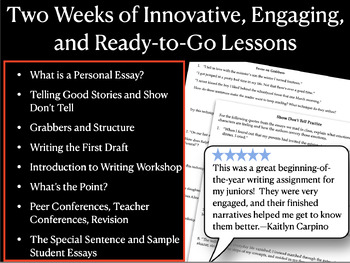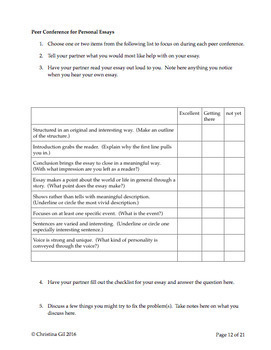Personal Narrative Writing Unit | College Application Essay | Prompts, Rubric
- PDF
What educators are saying
Description
Looking for a comprehensive narrative writing unit that will take your students from inspiration to finished product?
You want your students to become better writers, but it’s not easy to give them the instruction that will actually improve their skills. Simply explaining what good writing is or giving students worksheets to fill out about characteristics of writing won’t get them anywhere. In fact, it will only teach them that they are “bad at” writing and that there is no point in trying to improve.
What you need is a practical guide that will get students engaged in analyzing writing, discussing what makes good essays, and trying out different exercises themselves. This unit is both low-key and rigorous, and it has been honed over sixteen years of teaching. I have found great success teaching the personal and college application essay using these plans to all levels of students, from AP Literature classes to my most reluctant learners.
When you teach a narrative writing unit with these resources you will:
- get your classes past their writers block and inspired to write their essays when they freewrite on the the no-prep, high interest prompts
- teach your students that writing can be lots of fun when they read hilarious and touching example essays by published authors and actual students
- break down the elements of the personal essay such as grabbers, structure, description, and theme so that students comprehend how to build a great essay
- help your students write essays with ideas and meaning when they reflect on their own lives and look for the lessons they’ve learned
- engage your classes with fun, low-key games and activities focusing on sentence structure, story telling, and show don’t tell
- take your classes through the writing process—from prewriting to drafting to peer editing to revision—with the practical plans, handouts, and guides
- teach your students to conduct effective peer conferences when they use the time-tested peer editing checklist and unique process for peer conferences
- inspire your students to find their voices and get their message to the world when they read accessible real student sample essays and published mentor texts by some of the great writers of our time
- easily grade student work with the included rubric which focuses on all of the elements of the lessons
Teaching this tightly-structured unit will be a highlight of your year. You’ll get to know your students on a deeper level when you help them to explore their experiences and make sense of their own lives through writing and reflection.
Essays covered in this resource:
(Texts are not included because of copyright laws.)
"Fish Cheeks" by Amy Tan
“My Father Smokes” by Alice Walker
“The Inheritance of Tools” by Scott Russell Sanders
“Us and Them” by David Sedaris
"This was just what I needed to take my students through each stage of the writing process for their personal essays. The practical guides and real student essays were especially helpful!"--Buyer





